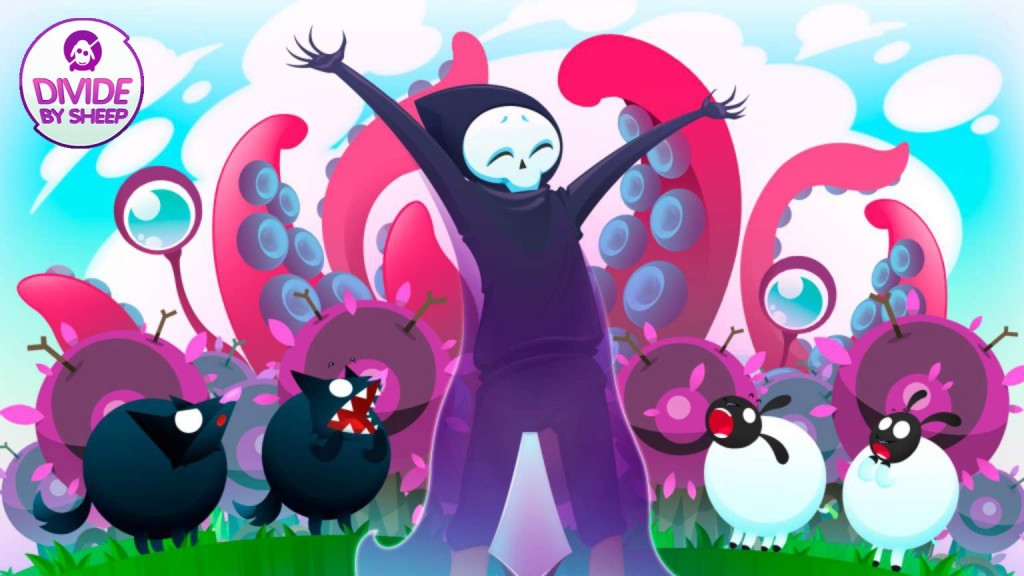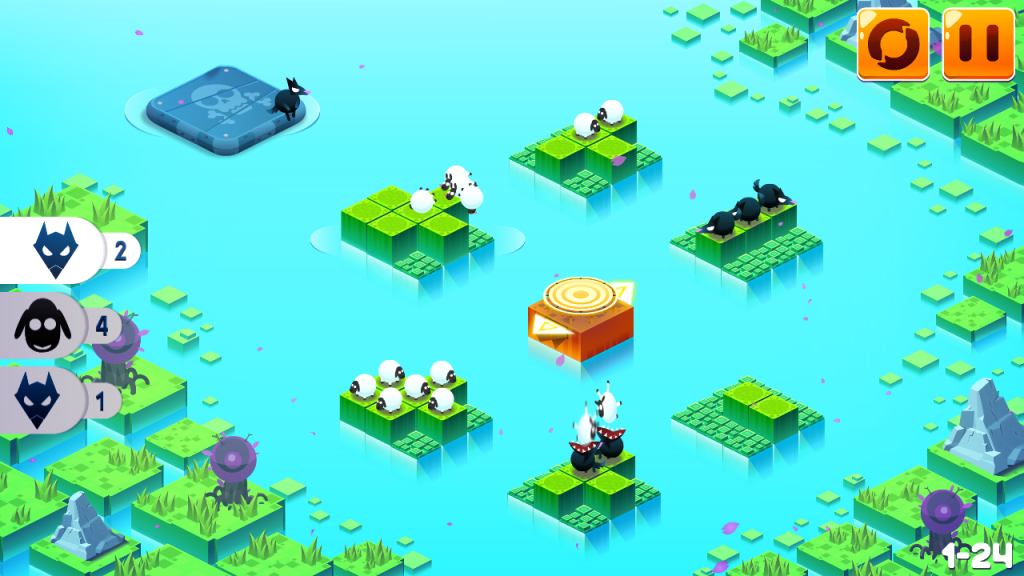 The mathematical concepts of tinyBuild’s latest app, Divide by Sheep, are simple, but the consequences are bloody. Very bloody.
The mathematical concepts of tinyBuild’s latest app, Divide by Sheep, are simple, but the consequences are bloody. Very bloody.
With previously published games like Party Hard (where the principal action is murdering noisy neighbors) or Dungelot (starring a pentagram-tattooed demon milk cow), most of tinyBuild’s games probably won’t be showing up in middle school math class. But when it comes to making a math game that balances fun visuals and simple, snappy gameplay with the ability to teach fractions, tinyBuild has seemed to find a winner.
Divide by Sheep is quite simply a math game for people who don’t like math games. Just ask co-founder and CEO Alex Nichiporchik.
“If education was fun, I wouldn’t have dropped out of high school,” Nichiporchik said. “I never really approached [Divide by Sheep] as an educational game first. Instead, I focused on it tricking you into doing math with great graphics and a silly premise. You never realize you’re doing equations and fractions.”
Since launching in 2011, game publisher and developer tinyBuild has built a reputation for creating games and characters with a dark sense of humor. But Nichiporchik said Divide by Sheep actually started as a math game based on platforms — the lasers and sheep slicing came later.
The $2.99 math puzzler debuted among the top 1000 grossing apps in the App Store after it’s July 2 debut, and it consistently ranks among the top 500 grossing puzzle games in the country.
“We learned that the game taunted people by its simplicity,” Nichiporchik recalled after spending an “insane” amount of time testing early versions of Divide by Sheep with curious gamers at PAX South and other gaming conventions as part of tinyBuild’s interactive booths.
“Whenever someone would spend a few minutes on a level, other bystanders would join in and collectively solve the puzzle. This is where we knew the gameplay worked. Getting the actual premise and story in was something we designed around the puzzles after the game’s design was more or less complete,” he said. “People need an emotional driver, the ‘why is this happening?’ part.”
Though perhaps lacking the subtlety and certainly the intention of an educational app like Innertube Game’s math puzzler Wuzzit Trouble or Motion Math’s school-focused suite of apps, Divide by Sheep does develop a player’s relationship to numbers. But the wooly slice-and-dicer operates first and foremost as games that just so happen to build your relationship and comfort level with numbers and fractions — whether you want them want to or not.
Working with The Bread Team, a small indie developer, tinyBuild decided to turn the “why is this happening” into the barest of stories: the grim reaper is lonely and decides to slaughter some sheep in order to keep him company. Questions? No? Good.
Much like the simplest games meant for very young players, Divide by Sheep’s narrative, such as it is, unfolds within bright, colorful comic-book style frames using almost no text and no voiceover.
Players must save the sheep from Death’s cruel and lonely clutches by bouncing the sheep across multiple platforms onto the relative safety of a life raft bound for safer pastures. As players progress through its 150 stages spread across five varied worlds, the difficulty ramps up quickly but not unfairly.
Initially, the game expresses its mathematic fundamentals by forcing players to round up groups of up to ten sheep onto platforms of up to ten spots. Any excess sheep plummet into the water, presumably to drown.

Divide by Sheep sans blood, but with sheep-eating wolves.
Once players get the hang of splitting and combining their flocks, Death adds obstacles to make the math harder. Barbed wire fences block easy access to life rafts, and black wolves prowl the platforms and devour any sheep that cross their path only to become docile and sleepy after eating a belly-full of mutton.
Just when you’ve tamed the wolves, the game introduces red laser beams that slice the sheep in half, which, in addition to adding a surprising amount of cartoonish gore, doubles as a clever gameplay mechanic by adding a layer of depth to the math. Players can recombine the eviscerated sheep halves by splatting them back together with duct tape and evacuating them onto the life raft, leaving only round bloody splotches behind. It’s more cute and ridiculous mischief than nightmare fodder.
“Seeing people trying to contain bursting into laughter at the sight of blood splatters and duct-taped sheep, that is priceless,” Nichiporchik said.
Defeat is momentary as the reset button is just a click away, allowing players to quickly retry different strategies without getting too frustrated. The game wants to test you, not break you.
Each stage has three sheep-rescue goals that reward up to three stars, a familiar format to anyone who’s played mobile games. The stars are used to unlock future worlds, each with their own theme — like snowy woodlands or misty, candle-lit dungeons.
Some players might get turned off by all the cute little sheep murder, but that’s not a problem for tinyBuild’s Nichiporchik. They weren’t trying to make an educational app in the first place.
“The problem with educational games in general is that they suck,” he said.
Though a commercial game developer like Nichiporchik could certainly find several educational counterparts who’d disagree, he’s certainly not the only one who actively shuns the “educational game” label, deserved or not.
Scott McLeod is Director of Learning, Teaching and Innovation at Prairie Lakes Area Education Agency, and co-author of “What School Leaders Need to Know About Digital Technologies and Social Media.”
He spends most of his time thinking and working on how to facilitate learning spaces and technologies for Iowa schools and their leadership. When McLeod wrote a post titled “Do Most Educational Games Suck?” on his tech blog a few years ago, he received nearly 100 responses, some from ed developers who felt slighted by his blunt assessment of their work.
“We see a lot of crap,” McLeod said. “I don’t know if we need another flashcard app, and if we did, it’s not going to be transformative. The hype for some of these apps is so overdone, but when you peel away the onion they only look sophisticated. But if you stick [a good game] into something that looks like it was built in the 90s, kids are going to look at it with a skeptical eye, too.”
McLeod says he’s been frustrated but the gaming options he’s seen so far, and access to math games that are little more than gamified worksheet apps aren’t on the radar yet in Iowa.
“That’s a pretty low bar to clear, though. If you ask a teacher, ‘What are some great apps?’ she probably has no idea, and the games she does know are plug-and-chug types. We want to know, ‘Where are the carefully curated and publicized math games that operate on a conceptual level?’”
The core of tinyBuild’s business model is to create partnerships with small developers, like The Bread Team, who want to design the next successful indie app. Nichiporchik writes a how-to-pitch blog for his site, and says developers interested in math or science-based games should always focus on the fun first.
“Even if it compromises your initial idea of a hardcore math game — if it’s no fun, nobody will play it. A game can’t be bland. It’s simple as that. If the emotion that spawns is laughter — great. Fear? Fantastic. Disgust? Maybe. A game can’t leave you emotionless, which is what we focus on,” Nichiporchik said.
